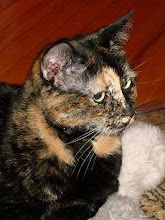Tulips are an ancient species that originated, not in Holland nor even in Turkey, as many may think, but rather in the colder, dryer parts of Russia and Central Asia. From the steppes and mountainous regions of the Caucasus, they were brought to Turkey around 1000 A.D. But it wasn't until Sultan Suleiman I (1494-1566), ruler of the Ottoman Empire, popularized tulips by cultivating them in the capital city of Constantinople (Istanbul) as a symbol of his wealth and power. During those early years, an inhabitant of Persia could literally lose his head for stealing a single bulb! Nonetheless, tulips did eventually spread throughout the expanding Persian-Turkish Empire.
 Following import from Turkey to Holland in the mid-1500's, an unusual quirk of nature resulted in the creation of dramatic variegated patterns in these flowers; patterns that were highly prized by the Dutch. The seemingly unpredictable outcome became known as "feathering", and today their genetically stabilized likeness is what horticulturists term Rembrandt Tulips. Smaller and more delicate, each flower is a veritable masterpiece.
Following import from Turkey to Holland in the mid-1500's, an unusual quirk of nature resulted in the creation of dramatic variegated patterns in these flowers; patterns that were highly prized by the Dutch. The seemingly unpredictable outcome became known as "feathering", and today their genetically stabilized likeness is what horticulturists term Rembrandt Tulips. Smaller and more delicate, each flower is a veritable masterpiece.How similar is the case with the kittens in our rescue groups. They are not the monochromatic purebred cats with papered pedigrees who register with societies and travel the country competing for ribbons. Rather, like the tulip, they are the smaller variety impacted by forces beyond their control that shape them into highly unique individuals. "Dog-people" especially will marvel that within a litter of six kittens, each can look so uniquely different. In my last post titled Choices, I included a photo of myself when I was only five weeks old. This prompted me to go through the entire family album and I found this picture which illustrates quite well the diversity of colors and patterns that kittens of the street may have. Can you find me in the pile? (click on picture to enlarge) Hint: I have some white toes at the ends of my outstretched back legs. If that's not enough, remember I'm a split-faced tortoiseshell.

Characteristically upside down, arms folded across his chest bat-like is my brother Vladimir, pure black. On the other side of me is Shere-Khan, with the color and markings of a Bengal tiger. Next to him is my beautiful sister Deirdre, a black and silver tabby "No common child..." (as is told in the legend). On top of her is Khia, my black and white marked sister whose mantra always was "To go where no kitten has gone before." Mocha has chocolate and coffee stripes on her coat of French vanilla, and you can just make out the warm swirls of red and brown and orange of Carmella's striped and spotted coat. Truly, just like Rembrandt Tulips, each one of my siblings has been painted by the hand of God.
But where tulips and kittens differ is on the inside. While both are beautiful on the outside, our true uniqueness lies within the variegated personalities each of us has been given. We have an inner strength that comes from a heritage of the wild forcing us to survive where life can be marginal. Our differences we embrace, knowing that people, too, are unique and that many have been forced to live though similarly difficult circumstances. In rescue we do rest assured that for every kitten, there is one special human with whom we will be a perfect match for many springtimes yet to come.
With purrs to all,
Sasha
------
Every feline is a masterpiece.
- Leonardo da Vinci

